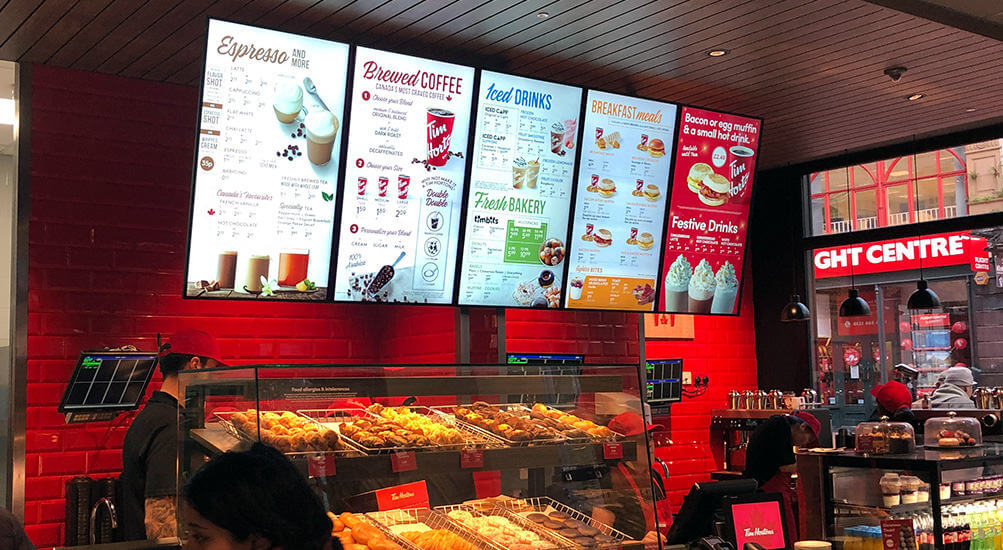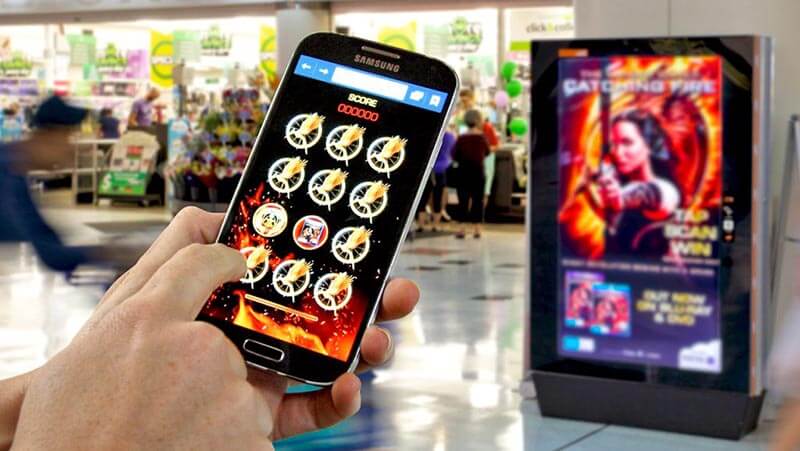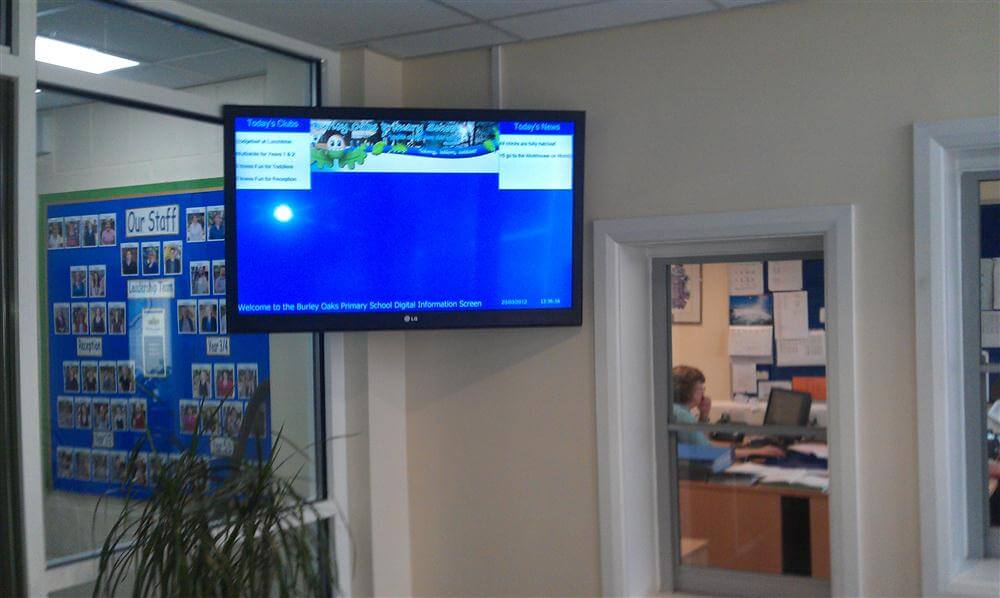Digital Signage
Introduction
Digital signage is a sub-segment of electronic signage. Digital displays use technologies such as LCD, LED, projection and e-paper to display digital images, video, web pages, weather data, restaurant menus, or text. They can be found in public spaces, transportation systems, museums, stadiums, retail stores, hotels, restaurants and corporate buildings etc., to provide wayfinding, exhibitions, marketing and outdoor advertising. They are used as a network of electronic displays that are centrally managed and individually addressable for the display of text, animated or video messages for advertising, information, entertainment and merchandising to targeted audiences.
Problem Statement
Prior to the advent of digital signage throughout the industries, electronic paper were used as display devices. Electronic paper were used to hold static texts and images indefinitely without electricity. The disadvantage to electronic paper as a form of digital signage is the limited reach of information transmission. Users that need to update the information will need to be in the same retail store, or be within the proximity for shopping malls. This required manual work from store staffs and shopping mall staff in maintaining the device with the latest information. To overcome these difficulties, the concept of digital signage was first discovered.
Features
The many different uses of digital signage allow a business to accomplish a variety of goals. Some of the most common applications include:
- Public information – news, weather, traffic and local (location specific) information, such as building directory with a map, fire exits and traveler information.
- Internal information - corporate messages, such as health & safety items, news and so forth.
- Product information – pricing, photos, raw materials or ingredients, suggested applications and other product information. These are especially useful in food marketing where signage may include nutritional facts or suggested uses or recipes.
- Information to enhance the customer service experience - interpretive signage in museums, galleries, zoos, parks and gardens, exhibitions, tourist and cultural attractions.
- Advertising and Promotion – promoting products or services, may be related to the location of the sign or using the screen’s audience reach for general advertising.
- Brand building – in-store digital sign to promote the brand and build a brand identity.
- Influencing customer behavior – navigation, directing customers to different areas, increasing the “dwell time” on the store premises and a wide range of other uses in service of such influence.
- Influencing product or brand decision-making - Signage at the point of sale designed to influence choice e.g. Signage to help shoppers to choose dresses inside a fashion store or devices that on a computerized shopping trolley helping the customer locate products, check prices, access product information and manage shopping lists.
- Enhancing customer experience – applications include the reduction of perceived wait time in the waiting areas of restaurants and other retail operations, bank queues, and similar circumstances, as well as demonstrations, such as those of recipes in food stores, among other examples.
- Navigation – with interactive screens (in the floor, for example, as with “informational footsteps” found in some tourist attractions, museums and the like) or with other means of “dynamic wayfinding”.
- Reservations – small, interactive screens on walls or desks that allow employees to reserve the space for a limited time and integrate with a room and resource scheduling platform.
Industry Overview
The predominant market users of digital signage are restaurants, retailers, office buildings, regional state and local planning authorities, public transport services, and various different industries.
Restaurants
Digital signage is used in restaurants through an interactive menu screen that rotates promotional offers. Restaurants use digital signage both indoors and outdoors, with the latter needing a form of weather protection depending on the components of the hardware. Outdoor usage of digital signage is most prevalent in drive-through that allows the customer to browse through the entire menu at a glance while also placing their order with an interactive touchscreen. Indoor digital signage is used for the display of menus. Prior to the integration of digital signage, restaurants manually updated the cafeteria menu, which is in itself a full-time job, especially if the menu is updated daily. With digital signage, restaurants do not have to manually update the menu feed, with live menu feed from digital signage solutions.

Shopping malls
Digital signage is widely used in shopping malls as a form of directory or map display. Uses of digital signage include a wayfinding kiosk, enabling the customer to find their path through an interactive touchscreen. Recent digital signage have begun combining interactive advertisement with wayfinding application. This will offer shoppers who interact with the advertisement of the tenant in the shopping mall to the store. Another usage is disseminating relevant information such as the schedule of an event or campaign.

Campaigns
Digital signage is used during exhibitions or marketing events to entice passersby. Digital signage aims to attract crowds to events and enhance visitor experience by making the experience memorable. Exhibitions use digital signage to create branding experiences.

Hospitality
The hospitality industry uses digital signage to display crucial information at a convenient and visible location for all its patron. A digital signage is capable of functioning as a virtual concierge in hotels and as entertainment for conferences during waiting room. Digital signage is also used in hotels as a form of wayfinding, to guide a large group of people for a conference to the correct room. It is used to provide a simple method to update information that is continuously changing such as expo information.

Cinema
Digital signage is placed in the lobby, concession stands and displays advertisement before the movie begins. This informs customers about other theater offerings and scheduling, increasing concession sales and gaining other sources of revenue.

Transport
Transport is a growing sector for digital signage with practical solutions, such as wayfinding.

Education
Digital signage can be used for school cafeteria menu boards, digitized noticeboards, and as an element of smart campuses.

Digital signage technology integrations
Interactivity
Interactive digital signage allows end users to interact with digital content via touchscreens, body sensors or QR codes via smartphones.
Context-aware digital signage
Context-aware digital signage leverages technologies such as sensors, cameras, beacons, RFID technologies, software programs and network connectivity to monitor the ambient environment, process information and deliver promotional messages based on environmental cues. Many digital signage products include cameras and gather shopper demographic data by estimating the age, gender and economic status of passers-by and use this information to update signage as well as to provide back-end analytics and shopper profiles.
Equipment and network infrastructure
Digital signs rely on a variety of hardware to deliver the content. The components of a typical digital sign installation include one or more display screens, one or more media players, and a content management server. Sometimes two or more of these components are present in a single device but typically there is a display screen, a media player, and a content management server that is connected to the media player over a network. One content management server may support multiple media players and one media player may support multiple screens.

